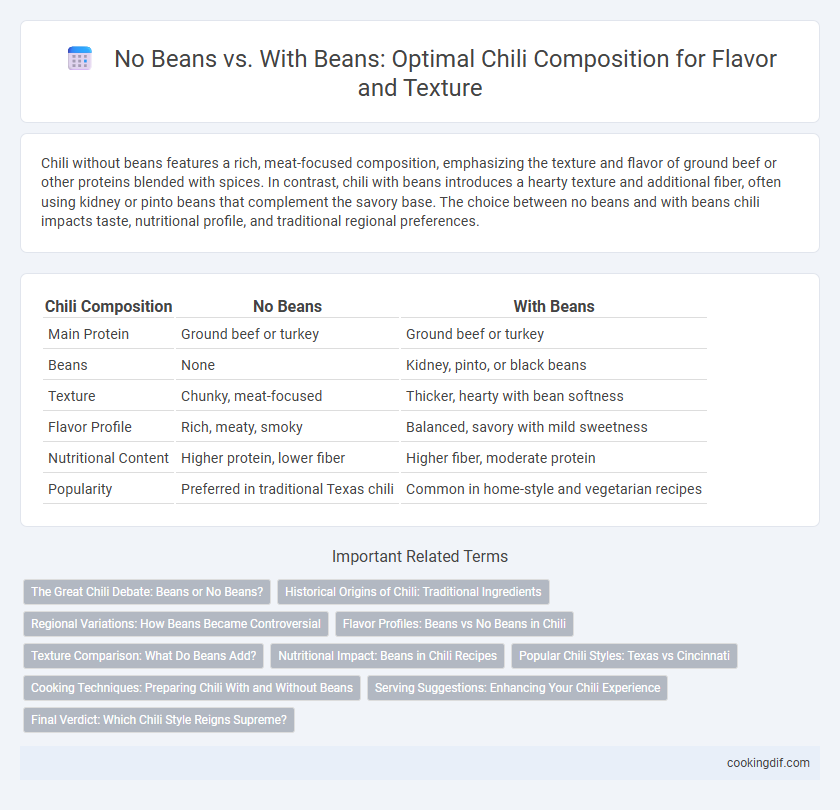Chili without beans features a rich, meat-focused composition, emphasizing the texture and flavor of ground beef or other proteins blended with spices. In contrast, chili with beans introduces a hearty texture and additional fiber, often using kidney or pinto beans that complement the savory base. The choice between no beans and with beans chili impacts taste, nutritional profile, and traditional regional preferences.
Table of Comparison
| Chili Composition | No Beans | With Beans |
|---|---|---|
| Main Protein | Ground beef or turkey | Ground beef or turkey |
| Beans | None | Kidney, pinto, or black beans |
| Texture | Chunky, meat-focused | Thicker, hearty with bean softness |
| Flavor Profile | Rich, meaty, smoky | Balanced, savory with mild sweetness |
| Nutritional Content | Higher protein, lower fiber | Higher fiber, moderate protein |
| Popularity | Preferred in traditional Texas chili | Common in home-style and vegetarian recipes |
The Great Chili Debate: Beans or No Beans?
The Great Chili Debate centers on whether to include beans, with purists insisting traditional Texan chili contains only beef, chili peppers, and spices, excluding beans entirely. Proponents of beans argue that adding pinto or kidney beans enhances flavor, texture, and nutritional value, making chili a heartier and more balanced meal. Regional variations heavily influence this preference, with Midwestern and Southwestern recipes often incorporating beans, while Texas-style chili remains bean-free.
Historical Origins of Chili: Traditional Ingredients
Chili's historical origins trace back to the Texas-Mexico border, where the traditional recipe notably excludes beans, emphasizing meat, chili peppers, and spices. Early chili con carne, also known as "chili," featured chunks of beef and dried chili peppers seasoned with cumin, garlic, and oregano, reflecting its roots among Mexican cowboys and Texan settlers. The incorporation of beans became popular later as a cost-effective addition, but authentic Texan chili maintains its identity without beans.
Regional Variations: How Beans Became Controversial
The debate over no beans versus with beans in chili composition reflects deep regional variations, particularly between Texas and other U.S. states. Texas chili, known as "Texas Red," traditionally excludes beans, emphasizing pure meat and chili peppers, while many other regions incorporate beans as a staple ingredient for texture and flavor. This controversy stems from regional culinary identities and historical cooking practices, making beans a symbolic element in defining authentic chili recipes.
Flavor Profiles: Beans vs No Beans in Chili
Chili with beans offers a rich, earthy flavor and a creamy texture that balances the spiciness with subtle sweetness from the legumes, enhancing depth and complexity. No-bean chili emphasizes the bold, meaty essence and robust blend of spices, delivering a more intense, savory profile with a concentrated heat. The choice between beans or no beans fundamentally shapes the overall flavor profile, influencing both texture and taste experience in classic chili dishes.
Texture Comparison: What Do Beans Add?
Beans add a creamy and hearty texture to chili, creating a contrast with the tender meat and vegetables. Without beans, chili has a smoother, more uniform consistency that highlights the chili spices and meat flavors. The inclusion of beans also enhances the chili's thickness and provides a satisfying bite, contributing to a more complex mouthfeel overall.
Nutritional Impact: Beans in Chili Recipes
Including beans in chili recipes significantly boosts dietary fiber, protein, and essential minerals like iron and potassium, enhancing overall nutritional value. No beans chili tends to be lower in carbohydrates and calories but may lack the fiber content crucial for digestive health. Choosing between no beans and with beans chili impacts macronutrient balance, with bean-containing versions promoting satiety and better blood sugar regulation.
Popular Chili Styles: Texas vs Cincinnati
Texas chili typically excludes beans, emphasizing a robust mix of beef, chili peppers, and spices to create a thick, meaty stew known as "chili con carne." In contrast, Cincinnati chili incorporates beans as a fundamental ingredient, often featuring a unique blend of Mediterranean spices and ground meat served over spaghetti. These regional variations reflect distinct culinary traditions and preferences within American chili cuisine.
Cooking Techniques: Preparing Chili With and Without Beans
Preparing chili with beans involves simmering dried or canned beans separately to ensure they achieve a tender, creamy texture before combining with the meat and spices, preserving their integrity during the cook. Cooking chili without beans typically requires longer cooking times for the meat and vegetables to develop depth, focusing on slow simmering techniques that meld flavors and create a hearty, thick consistency. Both methods benefit from layering spices early and adjusting seasoning throughout to balance the robust flavors unique to each chili style.
Serving Suggestions: Enhancing Your Chili Experience
Serving suggestions for chili without beans often emphasize pairing it with rice, cornbread, or tortilla chips to complement its rich, meaty flavor. Chili with beans benefits from toppings like shredded cheese, sour cream, and chopped onions, which add texture and balance to the dish's hearty, savory profile. Experimenting with garnishes such as sliced jalapenos, avocado, or fresh cilantro can enhance both versions, tailoring the chili experience to personal taste preferences.
Final Verdict: Which Chili Style Reigns Supreme?
No Beans chili highlights a rich, robust meat flavor favored in traditional Texan recipes, while With Beans chili offers added texture and fiber, appealing to those seeking a heartier meal. Nutritional benefits favor bean inclusion due to higher fiber and protein content, yet purists argue that authentic chili remains bean-free to preserve classic taste profiles. The final verdict depends on personal preference: No Beans triumphs in authenticity and concentrated meaty flavor, whereas With Beans wins for enhanced nutrition and variety.
No Beans vs With Beans for chili composition Infographic

 cookingdif.com
cookingdif.com